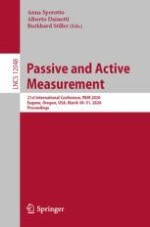2020 | Book
Passive and Active Measurement
21st International Conference, PAM 2020, Eugene, Oregon, USA, March 30–31, 2020, Proceedings
Editors: Anna Sperotto, Alberto Dainotti, Burkhard Stiller
Publisher: Springer International Publishing
Book Series : Lecture Notes in Computer Science
